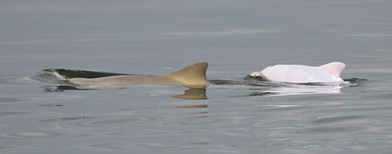
The research group, based at Univille university in Santa Catarina, said Thursday that it was the first recorded instance of an albino in the pontoporia blainvillei species, a very shy type of dolphin that rarely jumps out of the water. It's known in Brazil as Toninha and in Argentina and Uruguay as the La Plata or Franciscana dolphin.
Camilla Meirelles Sartori, the lead biologist of Project Toninhas, said she first saw the white calf with pinkish fins at the end of October. Her group photographed him in early November."We were surprised, shocked," Sartori said. "It's very small, and the color is really different. We didn't know what it was at first."
Sartori said the baby was with an adult, probably its mother. The young live on their mother's milk until they are six months old and remain dependent on the adult until they're a year old.
The species is endangered. Its dolphins have long, thin snouts and get easily tangled in fishing nets. They can drown or die of stress if not quickly released, Sartori said.
Since Herman Melville created the albino whale Moby Dick in 1851, rare albino marine mammals have held a special fascination.
Albinism is the lack of melanin pigments in the body, giving an individual very light or white skin and hair. Little is known about the genetic predisposition in dolphins because it's so unusual.
Sartori said the rarity of the baby spotted by her group only highlights the need to preserve the Bay of Babitonga in the southern Brazil state of Santa Catarina, where this population of endangered dolphins lives.
"Albino animals generally have fewer chances of survival because they have greater chances of being caught by predators," Sartori said. "Here, in this bay, they don't have natural predators. But there is a lot of environmental degradation from two ports, industrial and residential sewage, tourism. This is an another argument for its protection."

No comments:
Post a Comment